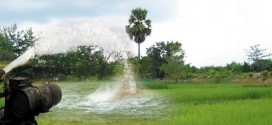Water moves through soil due to the force of gravity, osmosis and capillarity. At zero to one-third bar suction, water moves through soil due to gravity; this is called saturated flow. At higher suction, water movement is called unsaturated flow.
Water infiltration into soil is controlled by six factors:
- Soil texture
- Soil structure. Fine-textured soils with granular structure are most favourable to infiltration of water.
- The amount of organic matter. Coarse matter is best and if on the surface helps prevent the destruction of soil structure and the creation of crusts.
- Depth of soil to impervious layers such as hardpans or bedrock
- The amount of water already in the soil
- Soil temperature. Warm soils take in water faster while frozen soils may not be able to absorb depending on the type of freezing.
Water infiltration rates range from 0.25 cm (0.098 in) per hour for high clay soils to 2.5 cm (0.98 in) per hour for sand and well stabilised and aggregated soil structures. Water flows through the ground unevenly, called “gravity fingers”, because of the surface tension between water particles. Tree roots create paths for rainwater flow through soil by breaking though soil including clay layers: one study showed roots increasing infiltration of water by 153% and another study showed an increase by 27 times. Flooding temporarily increases soil permeability in river beds, helping recharge aquifers.
 Karshika Keralam – A site for Agricultural Enthusiasts
Karshika Keralam – A site for Agricultural Enthusiasts

